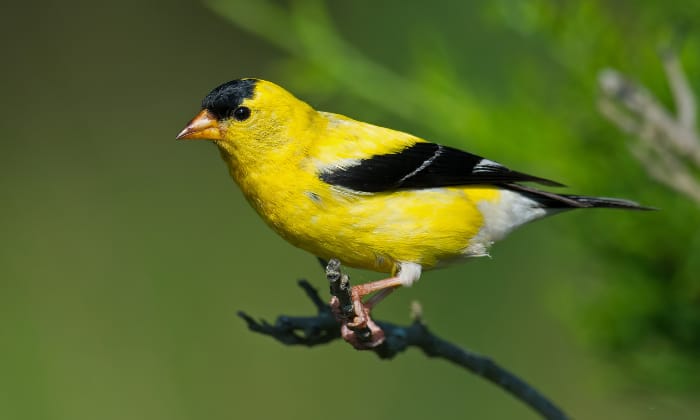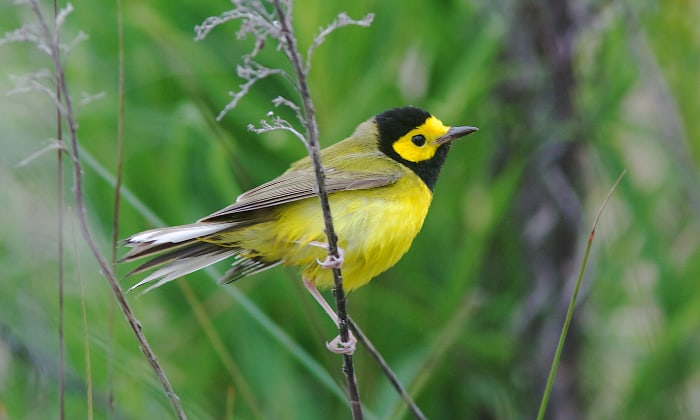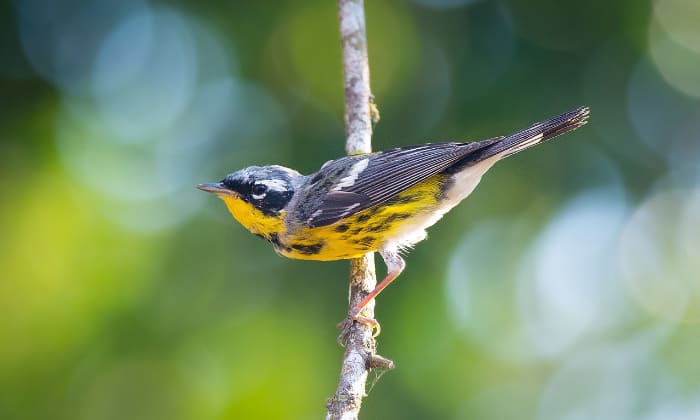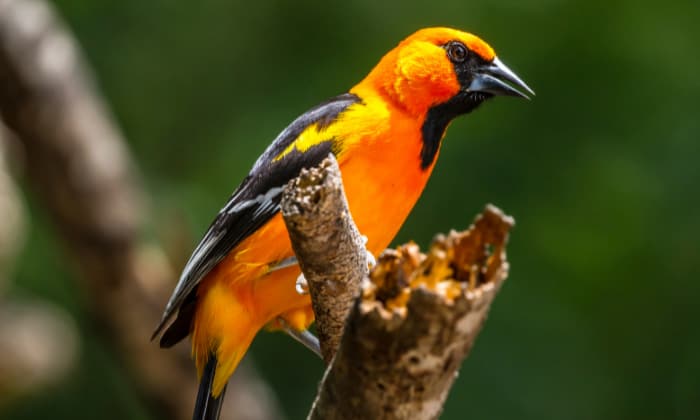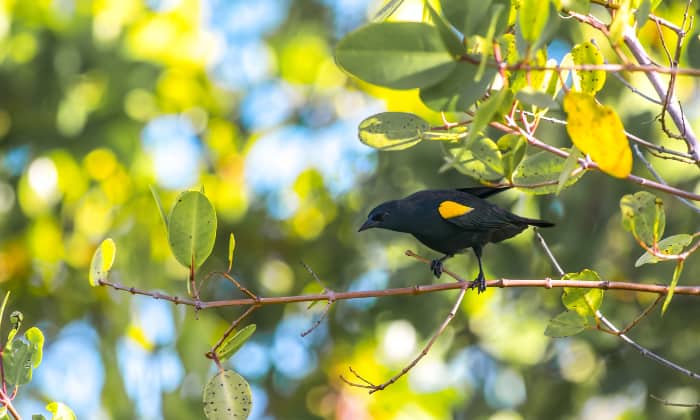One of the most familiar creatures visiting your backyard is small yellow and black bird. They are tiny and quick on their feet, often flying around and towards shrubs or trees. If you are in Texas or California, the chance of meeting them is even higher.
“What kind of bird is that?” Well, if you are into birdwatching. Read on to know all the yellow and black birds living around the world.
Table of Contents
9 Popular Small Yellow & Black Birds
1. American Goldfinch
The American Goldfinch (Scientific name: Spinus Tristis)
The distinct American Goldfinch is small with noticeable yellow and black feathers. Experience birdwatchers can recognize them at a glance due to the distinct white spots on their black feathers.
These birds enjoy providing fruit-bearing bushes and trees.
Notably, their colors change during different seasons, as their features are brighter every breeding season.
Female Goldfinch are less distinctive with their feathers, a combination of yellow, olive, and brown. Meanwhile, male Goldfinches are the most beautiful during their breeding season, which excites birdwatchers. They can be spotted with their brilliant yellow feathers combined with their shiny black wings.
Characteristics
- American Goldfinches’ breeding season is late compared to most other North American birds.
- Warmer months are coming if male goldfinches’ feathers are visibly bright yellow.
Locations
- The American Goldfinch’s habitat is in wide open spaces with trees and shrubs providing food and shelter.
- Their migration routes change with the seasons, but North Carolina, Canada, and Mexico are common places to fly.
2. Black and Yellow Tanager
Black and Yellow Tanger (Scientific name: Chrysothlypis Chrysomelas)
This small black and yellow bird weighs just 12.5 gram.
You can tell it is a male Black-and-Yellow Tanger if it has a vibrant yellow crown and body with black wings and tail. Its wings have visible white linings.
Female Black-and-Yellow Tanger have longer and pointier bills than males. Also, their color is less vibrant, and their body is usually slightly olive-green mixed with dirty-white belly.
Characteristics
- The Black-and-Yellow Tanger fly in smaller flocks, but they will sometimes flock together with those of other bird species.
- Their voice is rather scratchy and high.
Locations
- Wet forests around Panama and Costa Rica.
3. Hooded Warbler
The Hooded Warbler (Scientific name: Setophaga Citrina)
This bird is a little, only 13cm long olive-yellow-green bird, which distinguishes them from other black and yellow birds.
You can recognize them by their eyes, cheeks, and crowns covered with a brilliant yellow color. A black hood surrounds its face and throat, so from afar, it looks like a yellow bird with a black head.
But its underparts, upper back, and tail are olive green, while the rest of its small body is yellow.
Furthermore, the female Hooded Warbler has less vibrant colors and patterns than the males.
Characteristics
- During the breeding season, the male Hooded Warblers are the first to return to the mating areas. They will sing to mark out their territories.
- Male birds will sing in their territories’ borders to signal other male birds to back off.
Locations
- Central Ozarks, South and North America, Bahamas, Venezuela
4. Magnolia Warbler
Magnolia Warbler (Scientific name: Setophaga Magnolia)
It’s rather hard to spot this tiny songbird, as it only weighs only 6 to 15 grams and is 13 cm long.
A female Magnolia Warbler has a gray head with a yellow chest, a small bill, and a long tail with white streaks.
The male Magnolia Warbler also has yellow underpants, a grey forehead, and a small bill. Unlike females, males can be distinguished by their visible black streaks running down their throats to their bellies.
Characteristics
- The Magnolia Warbler males can sing two songs during their mating season. One song is to communicate with their female mates or to attract one. The other song is sung to protect its territory from other male rivals.
Locations
- Eastern United States and the Gulf of Mexico
5. Altamira Oriole
Altamira Oriole (Scientific name: Icterus Gularis)
The Altamira Oriole is a tropical bird, and it is frequently seen in open woodland. It is bigger than other birds in this list, with a length of 21 – 25 cm.
Both female and male Altamira Orioles have similar appearances – Pointed bills with black throats.
Their feathers are mixed with yellow, orange, and black colors, and they have long black tail feathers and black wings with traces of white streaks.
Also, an identifiable orange patch-like can be seen on matured birds’ shoulders.
Characteristics
- Male birds are the most vocal, particularly on the summer and spring mornings.
- Females can build 26-inch nests hanging in high branches.
- They sing like other Orioles species. They produce sounds of clucks, different notes of whistles, and loud chatters.
Locations
- US border in the Rio Grande’s lower basin, Gulf of Mexico, and the Pacific Coast
6. Golden-crowned Kinglet
Golden-crowned Kinglet (Scientific name: Regulus Satrapa)
The Golden-crowned kinglet is a tiny bird and is hard to spot in the wild.
Mature kinglets may be identified by their mixed back and underpart colors (gray and olive), short tails, and slender and short bills. Male adults have a yellow crown with an orange stripe in the center of their forehead.
During the summertime, Golden-crowned Kinglets could be seen flying around the areas with fir and spruce. You can still spot them in winter, for they are one of the birds that can withstand around -40 degrees.
Characteristics
- Hearing them is easy – Golden-crowned Kinglets are songbirds. You will know it is them if you see them and hear their thin and high-pitched calls.
- Golden-crowned kinglet males use their singing ability to defend nesting territory.
Locations
- North America, Northern Alberta, and Newfoundland.
7. Yellow-Shouldered Blackbird
Yellow-shouldered blackbird (Scientific name: Agelaius Xanthomus)
Both mature males and females measure 20 to 23 cm, but females are smaller than males.
This bird species looks very unique. Though its feather is completely black, its shoulders have a bright yellow patch. When they stand still, it’s hard to notice the yellow patch.
Characteristics
- These birds’s diet is mostly insects. They can also eat human food, such as rice and sugar.
- Their breeding season starts at the same time as the rainy season, so it’s not very consistent.
Locations
- They can be found in the wet and dry forests of Puerto Rico.
8. Evening Grosbeak
Evening Grosbeak (Scientific name: Coccothraustes Vespertinus)
The Evening Grosbeak has a thick and large bill that can break hard seeds. Its length is approximately 8.7 inches, and its wingspan is up to 14 inches.
Male Evening Grosbeak has a bright yellow body, dark grey head, black wings, and a yellow patch on its forehead.
The colors of the female birds’ feathers are soft and less striking. Their feathers are gray, white, and a hint of yellow.
Characteristics
- Evening Grosbeaks sing and dance for their partners and defend their homes, but there are no particular complicated songs they constantly sing.
- After their mating performances, Evening Grosbeaks couples bows, and the male will give some food to the female bird.
Locations
- They are found in high-altitude wooded areas.
- Countries where you can spot them are Canada, the United States, Mexico, and the British Isles.
9. Yellow-bellied siskin
Yellow-bellied Siskin (Scientific name: Spinus xanthogastrus)
Another bird with roots from Costa Rica is the yellow-bellied siskin. It’s also considered small as it only weighs 12 grams with a length of 10 – 11 cm.
It’s known as a black bird with yellow breast, due to its entire head, wings, and tails covered in black, contrasting with the bright yellow of its chest.
Characteristics
- They have a nice bird song of chattering twitter.
- Their breeding and nesting place is quite high, more than 800 m above the water level.
Locations
- Highlands of Venezuela, Central Costarica, and Bolivia
Conclusion
Overall, studying the birds’ migration patterns, breeding seasons, and food supplies is very helpful in finding them. Now that you have read our article about a small yellow and black bird; hopefully, it will help you find one in your next birdwatching.
Birds with yellow and black feathers are fascinating to look at. If you are lucky to spot one, take a snap or just admire their beauty.

George and I became friends after a birdwatching trip with our new group. And we have been enjoying every adventure together. When he told me the idea of establishing a site that shares our experiences and fun, I immediately agreed. After trials and errors, here we have Thayerbirding.



